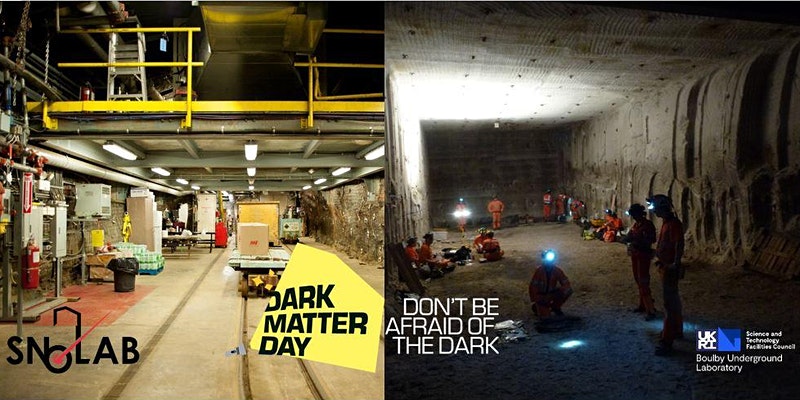News & Events
Dark Matter Day: Make it, Break it, Shake it!
Date: October 28, 2021
Time: 9:30pm - 11:30pm
Join us to learn about the mysterious dark matter
When we look around our world, and out into space, there is an enormous variety – trees and birds and planets and stars; however, everything that we can see and touch, “visible matter”, accounts for only 5% of the Universe.
It turns out that most of the matter in the Universe is dark. It doesn’t reflect or emit light and as far as we’ve ever seen, it doesn’t interact with any other particles. We can only see its effects through gravity – it’s very heavy, and we observe these effects through the motion of galaxies and the bending of light in gravitational lensing. Since the postulation of dark matter in the 1930s, scientists have been trying to learn more about it – in one of three ways, making it, breaking it and shaking it!
Free registration is required: https://www.eventbrite.co.uk/e/dark-matter-day-make-it-break-it-shake-it-tickets-183239523347

This joint event, brings together SNOLAB, STFC Boulby Underground Laboratory, the University of Edinburgh and the University of Manchester, to celebrate Dark Matter Day. It will begin with a short introduction to dark matter by Nobel Laureate, Art McDonald, before hearing from Caterina Doglioni about how we are trying to make dark matter at the Large Hadron Collider. Alberto Oliva, from the Alpha Magnetic Spectrometer, will explain how we are trying to find dark matter by breaking it, and then Jeter Hall will explain how they’re attempting to ‘shake’ it at SNOLAB.
After a short break, we’ll travel deep underground to visit two of the most fascinating – and unusual! – laboratories in the world, located in working mines in Canada and the UK. Both SNOLAB and the STFC Boulby Underground Laboratory are helping in the search for dark matter – as well as many other types of amazing science – and this is a great opportunity to learn more about them and meet some of the people who work in these unique locations. We’ll finish up with a panel discussion and a question and answer session.
The talk will be run over Zoom webinar, and there will be plenty of opportunities to ask questions, and it will also be streamed. If you cannot make the event live, but would like to receive a recording, please register and select the appropriate option.
If you have any questions, please email visitral@stfc.ac.uk.
About the laboratories and speakers:
SNOLAB is Canada’s deep underground research laboratory, located in Vale’s Creighton mine near Sudbury, Ontario, Canada. It provides an ideal low background environment for the study of extremely rare physical interactions. SNOLAB’s science programme focuses on astroparticle physics, specifically neutrino and dark matter studies, though its unique location is also well-suited to biology and geology experiments. SNOLAB facilitates world-class research, trains highly qualified personnel and inspires the next generation of scientists.
STFC Boulby Underground Laboratory is the UK’s deep underground science facility located 1.1km below ground in Boulby mine, a working potash, polyhalite and salt mine in the North East of England. Boulby is a special place for science, enabling a wide range of studies requiring access to the geologically interesting and ultra-low background deep underground environment. Science at Boulby ranges from low background astroparticle physics to studies of geology/geophysics, climate, the environment, planetary exploration technology development, life in extreme environments on Earth and beyond.
Art McDonald: Art is a Nobel Laureate and a Professor Emeritus in physics at Queen’s University. Since 1989, he has been the Director of the Sudbury Neutrino Observatory experiment and in 2015 he received the Nobel Prize for SNO’s part in solving the solar neutrino problem. Art is a member of the Darkside collaboration searching for dark matter.
Caterina Doglioni: Caterina is a professor of particle physics at the University of Manchester, with a joint appointment at Lund University. Her research is driven by finding out more about the known (and unknown) constituents of matter using “big science” tools, and she is a member of the ATLAS experiment at the Large Hadron Collider.
Alberto Oliva: Alberto is an astroparticle physics researcher of the Italian “Istituto Nazionale di Fisica Nucleare” (National Institute for Nuclear Physics). He is a senior scientist of the AMS-02 collaboration (https://ams02.space/), an experiment running on the International Space Station since 2011, able to detect high-energy particles produced in the cosmos, the so-called cosmic rays.
Jeter Hall: Jeter is the Director of Research at SNOLAB. He has experience working on a number of direct detection dark matter experiments, and in his current role ensures the lab’s research program continues its tradition of supporting high-quality, cutting-edge astroparticle physics.
Emma Meehan: Emma is the Senior Science Technician at the STFC Boulby Underground Laboratory. She heads up the science support team, manages and operates part of the facility called BUGS and manages the public engagement, outreach, comms, and wellbeing for the lab. She has been a part of the team at Boulby since 2010 and won the IOP Technician of the Year award in 2019.
Pierre Gorel: Pierre is a Research Scientist at SNOLAB. He has worked on neutron decay and neutrino experiments in the past, and currently focuses his efforts on direct dark matter searches as part of both the DEAP-3600 and NEWS-G collaborations.
